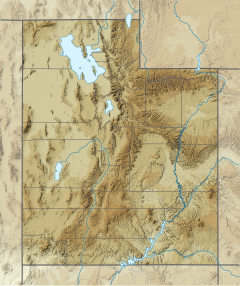Kimball Creek is a 1.9-mile-long (3.1 km)[1] west-flowing stream that begins 5.7 miles (9.2 km) north of Park City, Utah, on the east side of the summit of the Wasatch Range. It is one of the upper reaches of the East Canyon Creek watershed in Summit County, Utah, which in turn is a tributary to the Weber River, and ultimately to the Great Salt Lake.
| Kimball Creek | |
|---|---|
 Map showing the confluence of Kimball Creek and McLeod Creek, the source of East Canyon Creek, just north of Interstate 80, near Park City, Utah. | |
| Location | |
| Country | United States |
| State | Utah |
| Region | Summit County, Utah |
| Physical characteristics | |
| Source | Eastern slope of the Wasatch Range |
| • location | 6 miles (9.7 km) north of Park City, Utah |
| • coordinates | 40°44′08″N 111°30′03″W / 40.73556°N 111.50083°W[1] |
| • elevation | 6,411 ft (1,954 m) |
| Mouth | Confluence with McLeod Creek, the beginning of East Canyon Creek |
• location | 1.4 miles (2.3 km) east of Kimball Junction, Utah |
• coordinates | 40°43′26″N 111°31′07″W / 40.72389°N 111.51861°W[1] |
• elevation | 6,300 ft (1,900 m) |
| Length | 1.9 mi (3.1 km) |
History
editKimball Creek is named for a rancher named George Kimball. It passes through Kimball Stage Stop, a ranch stage stop owned by William H. Kimball, and where he built a rock stage structure that still stands. From there Kimball Creek flows 1.5 miles (2.4 km) west through Kimball Junction.[2][3]
Watershed and course
editKimball Creek begins just west of Silver Creek Road (the northerly extension of north Highway 40, and just north of Interstate 80. Shortly after its source, it is joined on the left by a larger stream named McLeod Creek,[4] and this confluence forms the source of East Canyon Creek, a tributary of the Weber River, and ultimately, the Great Salt Lake.[5] Note the Geographic Names Information System (GNIS) likely needs to be corrected to be consistent with the U.S. Geological Survey report and map.
Ecology and conservation
editBonneville cutthroat trout (Oncorhynchus clarkii utah) is a Utah Sensitive subspecies of cutthroat trout and was the native trout species in the East Canyon Creek watershed, however it is thought to be extirpated due to decreased flows, increased nutrient input, degradation to water and habitat quality, and depredation by non-native introduced brown trout (Salmo trutta) and possibly by hybridization with non-native introduced rainbow trout (Oncorhynchus mykiss).[6]
See also
editReferences
edit- ^ a b c U.S. Geological Survey. National Hydrography Dataset high-resolution flowline data. The National Map Archived 2012-03-29 at the Wayback Machine, accessed July 21, 2023
- ^ "Kimball Junction". Geographic Names Information System. United States Geological Survey, United States Department of the Interior. which lies at the intersection of Interstate 80 and Highway 224
- ^ John W. Van Cott (1990). Utah Place Names: A Comprehensive Guide to the Origins of Geographic Names: a Compilation. Salt Lake City, Utah: University of Utah Press. p. 214. ISBN 978-0-87480-345-7.
- ^ "McLeod Creek". Geographic Names Information System. United States Geological Survey, United States Department of the Interior.
- ^ C.D. Wilkowske (2005). Seepage Study of McLeod Creek and East Canyon Creek near Park City, Summit County, Utah, 2004, Scientific Report Report 2005-5164 (PDF) (Report). Reston, Virginia: U.S. Geological Survey. Retrieved July 22, 2023.
- ^ Carl Adams; Linda Burfitt; Kari Chalker; Catherine Chatfield; John Christensen; Doug Davidson; Erica Gaddis; J. Hope Hornbeck; Greg Larson; Kari Lundeen; Audrey McCulley; Jerry Miller; Megan Nelson; David Reinhart; Laura Burch Vernon (May 1, 2020). East Canyon Reservoir and East Canyon Creek Total Maximum Daily Loads (TMDLs) (Report). Salt Lake City, Utah: Utah Division of Water Quality. Retrieved July 20, 2023.
